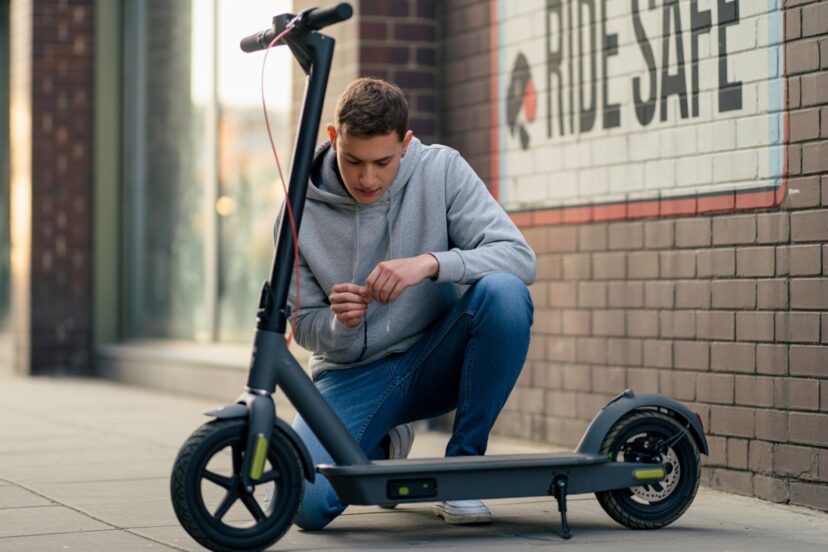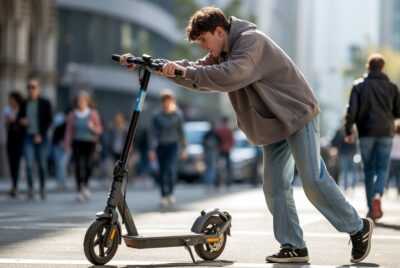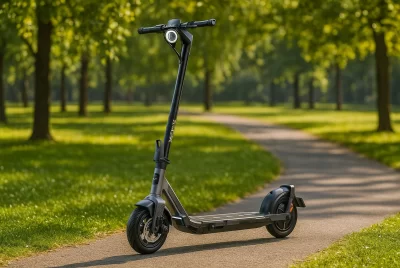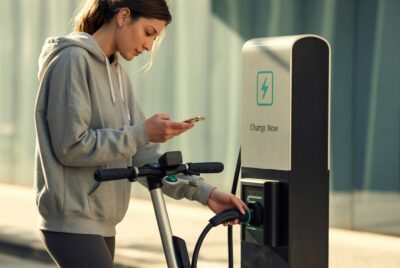E-Scooter Brake Failure: Emergency Tips to Stay Safe on the Road
*We may earn a commission for purchases made using our links. Please see our disclosure to learn more.
The morning commute starts like any other—smooth pavement beneath the wheels, the familiar hum of the electric motor, and the satisfying convenience of bypassing traffic. But then, approaching a busy intersection, the brake lever pulls all the way to the handlebar with no resistance. The sinking realization hits: the brakes have completely failed, and the scooter continues gaining momentum toward oncoming traffic.
This nightmare scenario plays out more frequently than most riders expect. Industry reports indicate that brake-related incidents account for nearly 40% of e-scooter accidents, with complete brake failure being a leading cause of serious injuries. The rapid growth of e-scooter adoption has outpaced safety education, leaving many riders unprepared for critical emergency situations.
Understanding brake failure isn’t just about mechanical knowledge—it’s about developing the confidence and skills needed to navigate urban environments safely. Whether dealing with worn brake pads, snapped cables, or electronic system malfunctions, every e-scooter rider needs a comprehensive emergency action plan that can be executed instinctively when seconds matter most.
“The key to e-scooter safety isn’t just about having good brakes—it’s about knowing what to do when they fail. Preparation and quick thinking can mean the difference between a minor scare and a serious accident.”
– Urban Mobility Safety Institute
Key Takeaways:
- Master the foot brake technique – Use your foot to drag on the ground as an emergency brake
- Lean back and lower your center of gravity – Shift weight backwards to maintain stability
- Look for safe stopping areas – Scan ahead for grass, uphill slopes, or open spaces
- Regular maintenance prevents most failures – Check brake cables and pads weekly
- Stay calm and avoid panic steering – Sudden movements can cause loss of control
Understanding E-Scooter Brake Systems
Modern e-scooters typically feature two main types of braking systems: mechanical disc brakes and electronic regenerative braking. Many models combine both systems for optimal stopping power. However, like any mechanical system, these components can fail due to wear, weather conditions, or manufacturing defects.
The complexity of these braking systems means that failure can occur in various ways. Sometimes, brake cables stretch or snap, leaving mechanical brakes unresponsive. In other cases, electronic systems may malfunction due to software glitches or electrical failures. Weather conditions like rain or extreme temperatures can also compromise brake performance, creating dangerous situations for unprepared riders.
Understanding your specific e-scooter’s braking system is crucial for both prevention and emergency response. Take time to familiarize yourself with how your brakes feel and sound during normal operation. This baseline knowledge will help you detect problems early and respond appropriately when issues arise.
Emergency Response: Your Action Plan
Immediate Response Techniques
When brake failure occurs, your first instinct might be to panic, but staying calm is crucial for executing effective emergency maneuvers. The most important thing to remember is that you have several alternative stopping methods at your disposal.
The Foot Brake Method remains the most reliable emergency stopping technique. Gently lower one foot to the ground and gradually increase pressure to create friction. Start with light contact to avoid sudden deceleration that could throw you forward. This method works best on flat surfaces and at moderate speeds.
Weight Distribution plays a critical role in maintaining control during emergency stops. Shift your weight backward by leaning away from the handlebars while keeping your knees slightly bent. This stance helps prevent forward momentum from throwing you over the handlebars when you begin emergency braking procedures.
Steering for Safety involves looking ahead for the safest available stopping zone. Grass areas, uphill slopes, or wide-open spaces provide better stopping options than concrete or asphalt. Gentle steering adjustments help guide you toward these safer areas without causing loss of control.
Advanced Emergency Techniques
For riders comfortable with more advanced techniques, controlled weaving can help reduce speed through increased friction and longer stopping distance. Make gentle S-turns to extend your travel path and naturally slow your momentum. However, only attempt this technique if you have sufficient space and experience with e-scooter handling.
Environmental assistance can also help in emergencies. Look for natural stopping aids like curbs (for controlled side contact), barriers you can safely grab, or even other people who can help slow you down. Always communicate your situation clearly if seeking assistance from others.
The jump and roll technique should be considered only as a last resort when collision seems inevitable. This advanced technique requires practice and should only be attempted at low speeds. The goal is to separate yourself from the scooter before impact, allowing you to control your landing rather than being trapped in a collision.
Common Brake Failure Scenarios
Weather-Related Failures
Rain and wet conditions significantly impact brake performance across all e-scooter models. Water can reduce friction in brake pads and make electronic systems behave unpredictably. During wet weather riding, test your brakes gently at the beginning of each ride and maintain extra following distance from obstacles and other riders.
Cold weather presents unique challenges as brake cables can contract and electronic systems may respond slower than normal. Lithium batteries that power electronic braking systems also perform differently in extreme temperatures, potentially reducing braking effectiveness when you need it most.
Mechanical Wear and Tear
Brake pad deterioration happens gradually but can reach critical failure points suddenly. Regular inspection of brake pads for wear indicators helps prevent unexpected failures. Most quality e-scooters include visual wear markers, but learning to recognize the feel of worn brakes is equally important.
Cable stretch and breakage represent another common failure mode. Brake cables undergo constant tension and release cycles, gradually stretching over time. Eventually, this stretch can become severe enough that the brake lever travels its full range without engaging the brake pads effectively.
Electronic System Malfunctions
Modern e-scooters rely heavily on electronic braking systems, which can fail due to software glitches, electrical connection problems, or component failures. Unlike mechanical failures that often provide warning signs, electronic failures can occur suddenly without obvious indicators.
Battery-related braking issues occur when the scooter’s main battery reaches critically low levels. Some models reduce or disable electronic braking functions to preserve power for basic motor operation, leaving riders with only mechanical backup systems.
Preventive Maintenance: Your First Line of Defense
Weekly Inspection Routine
Developing a consistent pre-ride inspection routine dramatically reduces the likelihood of brake failure. Check brake lever feel and travel distance, ensuring that both mechanical and electronic systems respond appropriately to input. Squeeze brake levers firmly and verify that they return to their resting position smoothly.
Visual inspection of brake components reveals many potential problems before they become dangerous. Look for frayed cables, worn brake pads, loose connections, and signs of oil or fluid leaks around brake assemblies. Any unusual wear patterns or damage should be addressed immediately by qualified technicians.
Seasonal Maintenance Considerations
Different seasons present unique maintenance challenges for e-scooter brake systems. Spring maintenance should focus on addressing winter damage from salt, moisture, and temperature extremes. Clean all brake components thoroughly and lubricate moving parts according to manufacturer specifications.
Summer heat can cause brake fluid to expand and electronic components to overheat. Ensure proper ventilation around brake assemblies and avoid prolonged high-speed riding that generates excessive heat in brake systems.
Fall preparation involves protecting brake systems from increased moisture and debris. Consider applying protective treatments to exposed metal components and ensure that drainage systems around brake assemblies function properly.
Winter storage requires special attention to prevent corrosion and component degradation. Clean and dry all brake components before storage, and consider using protective covers or storage solutions that maintain proper humidity levels.
Building Your Emergency Skillset
Practice Scenarios
Safe practice of emergency braking techniques builds muscle memory and confidence for real emergency situations. Find a large, empty parking lot or similar safe space to practice foot braking, weight shifting, and controlled steering maneuvers. Start at very low speeds and gradually increase your comfort level with each technique.
Controlled environment training allows you to experience brake failure scenarios without real danger. Have a friend or family member hold your e-scooter’s rear brake lever to simulate sudden brake failure while you practice emergency response techniques. This type of training helps you react appropriately when real emergencies occur.
Mental Preparation
Visualization exercises help prepare your mind for emergency situations. Regularly imagine different brake failure scenarios and mentally rehearse your response techniques. This mental preparation helps reduce panic and improves decision-making during actual emergencies.
Situational awareness training involves consciously observing your riding environment for potential stopping areas and escape routes. Make this a habit during regular rides, constantly scanning ahead for grass areas, uphill slopes, or wide-open spaces that could serve as emergency stopping zones.
Recovery and Post-Incident Procedures
Immediate Post-Emergency Assessment
After successfully managing a brake failure emergency, take time to assess both yourself and your e-scooter for any damage or injuries. Even minor incidents can result in delayed injuries or hidden damage that could cause future problems.
Check your e-scooter thoroughly before attempting to ride again. Brake failure often indicates broader mechanical problems that could affect other systems. Have your scooter inspected by qualified technicians before returning to regular use.
Learning from Experience
Each brake failure incident provides valuable learning opportunities for improving future safety. Document what happened, what techniques worked well, and what you might do differently in similar situations. This reflection helps build better emergency response skills over time.
Share your experience with other e-scooter riders through community forums or safety groups. Your experience could help others prepare for similar situations and contribute to overall community safety awareness.
Community Safety and Responsibility
Helping Others in Emergency Situations
When witnessing another rider experiencing brake failure, you can provide valuable assistance while maintaining your own safety. Call out warnings to help clear their path, and be prepared to offer physical assistance if they request help stopping safely.
Communication techniques during emergencies help coordinate assistance efforts. Learn basic hand signals and verbal commands that can help direct emergency stopping assistance from other riders or pedestrians.
Advocacy for Better Safety Standards
Supporting improved safety standards in e-scooter design and manufacturing benefits the entire riding community. Participate in safety discussions with manufacturers and regulatory bodies, sharing real-world experiences that can inform better safety features and requirements.
Education and awareness campaigns help spread critical safety information throughout the e-scooter community. Consider volunteering with local safety organizations or participating in community education events focused on e-scooter safety.
Technology and Innovation in Brake Safety
Emerging Safety Technologies
New developments in e-scooter brake technology promise improved safety and reliability for future riders. Advanced electronic systems with multiple redundancies, improved brake pad materials, and better integration between mechanical and electronic systems all contribute to enhanced safety.
Predictive maintenance systems use sensors and data analysis to identify potential brake problems before they become dangerous. These systems can alert riders to necessary maintenance and help prevent unexpected brake failures.
Smart Safety Features
Modern e-scooters increasingly include smart safety features that can assist during brake failure emergencies. Automatic hazard detection, emergency alert systems, and integrated communication tools all contribute to safer riding experiences.
Integration with mobile apps provides real-time brake system monitoring and maintenance reminders. These tools help riders stay informed about their scooter’s condition and take proactive steps to prevent brake failures.
Conclusion
E-scooter brake failure, while frightening, doesn’t have to result in serious injury when you’re prepared with the right knowledge and techniques. The key to safety lies in combining regular maintenance practices with emergency response skills and situational awareness. By understanding your e-scooter’s brake systems, practicing emergency techniques, and maintaining a safety-first mindset, you can confidently navigate the challenges of modern urban mobility.
Remember that every ride presents an opportunity to reinforce good safety habits and improve your emergency response skills. The techniques and strategies outlined in this guide provide a foundation for safe e-scooter operation, but continuous learning and practice remain essential for long-term safety success.
The e-scooter community benefits when every rider takes responsibility for their own safety while supporting others in developing better safety practices. Share your knowledge, learn from others’ experiences, and contribute to making e-scooter riding safer for everyone who chooses this convenient and environmentally friendly transportation option.
Frequently Asked Questions
Q: How often should I check my e-scooter brakes for potential problems?
A: You should perform a basic brake check before every ride, testing both mechanical and electronic systems for proper response. Conduct a more thorough inspection weekly, examining brake pads, cables, and connections for wear or damage. Professional maintenance should be performed according to your manufacturer’s schedule, typically every 3-6 months depending on usage.
Q: What’s the safest speed to ride at to minimize brake failure risks?
A: While there’s no universally safe speed, most safety experts recommend keeping speeds below 15 mph in urban environments and below 10 mph in crowded areas. Higher speeds increase stopping distances and reduce reaction time, making brake failure emergencies more dangerous. Always ride at speeds that allow you to stop safely using alternative methods if your primary brakes fail.
Q: Can I continue riding my e-scooter after experiencing brake failure?
A: Never continue riding an e-scooter after brake failure until the system has been thoroughly inspected and repaired by qualified technicians. Brake failure often indicates broader mechanical problems that could affect other safety systems. Even if you successfully managed the emergency, underlying issues may cause repeated failures or other dangerous malfunctions.
Q: Are there any warning signs that indicate my brakes might fail soon?
A: Yes, several warning signs can indicate impending brake failure: brake levers feeling spongy or requiring more travel than usual, unusual noises during braking, reduced stopping power, vibration through the brake lever, and electronic error messages on your display. Address any of these symptoms immediately to prevent dangerous brake failures.
Q: What should I do if my brakes fail while going downhill?
A: Downhill brake failure requires immediate action: lean back to shift weight away from the front wheel, use your foot as a drag brake with gradually increasing pressure, look for uphill escape routes or soft surfaces like grass, and consider controlled contact with barriers or curbs if necessary. Avoid sudden steering movements that could cause loss of control, and prepare for emergency dismounting techniques if safe stopping isn’t possible.




